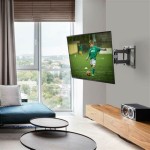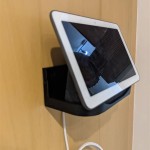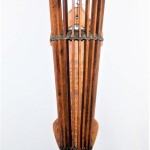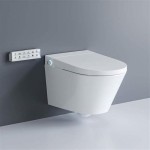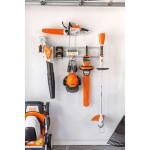How High Should a TV Be Wall Mounted?
Determining the ideal height for wall mounting a television is crucial for achieving optimal viewing comfort and preventing potential neck strain. While there is no universally perfect height, general guidelines and considerations can help determine the best placement for a specific viewing environment. This article explores the key factors influencing TV mounting height, offering a practical approach to achieving an ergonomic and visually pleasing setup.
The primary goal when mounting a TV is to position it so that the viewer’s eyes are level with, or slightly below, the center of the screen during typical viewing sessions. This minimizes the need to tilt the head upward for prolonged periods, which can lead to discomfort and muscle fatigue. Factors like seating height, screen size, and viewing distance all play a significant role in determining the appropriate mounting height.
Understanding the Eye-Level Principle
The cornerstone of determining the correct TV mounting height is the principle of aligning the viewer’s eye level with the center of the screen. To apply this principle effectively, it's necessary to first determine the average eye level when seated in the primary viewing position. This involves measuring the distance from the floor to the viewer's eyes while seated on the sofa, chair, or other preferred seating arrangement. This measurement provides a baseline for calculating the ideal TV height.
Standard seating height, especially for sofas, typically ranges from 16 to 20 inches. This usually places the average eye level between 40 and 48 inches from the floor. Taking this measurement is crucial, as seating variations are significant. For example, bar stools or recliners will drastically change the optimal screen placement from a standard sofa configuration. The accuracy of this measurement will directly impact viewing comfort.
Once the eye level is established, the goal is to position the center of the TV screen at, or slightly below, this height. Mounting the TV too high forces the viewer to look upward, causing neck strain. Conversely, mounting it too low might require the viewer to look downward, which can also lead to discomfort, although this is generally less common.
The exact placement may vary based on personal preference and individual tolerance for neck movement. Some individuals may prefer the center of the screen to be exactly at eye level, while others might find a slightly lower position more comfortable. Experimentation within a narrow range around the measured eye level height can help determine the optimal setting for individual needs.
Considering Screen Size and Viewing Distance
While eye-level is the primary factor, screen size and viewing distance are also critical considerations. Larger screens viewed from a closer distance require a lower mounting height to maintain a comfortable viewing angle. Conversely, smaller screens viewed from a greater distance can be mounted slightly higher without causing discomfort. The relationship between these three elements is crucial for creating an immersive and ergonomic viewing experience.
A common recommendation is to maintain a viewing distance that allows the entire screen to be viewed without excessive head movement. This distance is generally calculated by multiplying the diagonal screen size by a factor ranging from 1.5 to 2.5, depending on personal preference and screen resolution. For example, a 55-inch TV might be viewed comfortably from a distance of 82.5 to 137.5 inches (approximately 7 to 11.5 feet).
If the viewing distance is relatively short for the screen size, the TV should be mounted lower to avoid visual fatigue. When the screen is too large for the viewing distance, the viewer may have to constantly scan the screen to follow the action, leading to eye strain and discomfort. Conversely, if the viewing distance is too great, details on the screen may be difficult to discern, diminishing the viewing experience.
Furthermore, the viewing angle should be minimized to reduce distortion and maintain image quality. A steeper viewing angle, especially from below, can result in color shifting and reduced contrast. A slight downward tilt of the TV can sometimes compensate for a higher mounting position, but it is preferable to adjust the mounting height itself to achieve the optimal viewing angle in the first place.
Accounting for Specific Room Conditions and Preferences
Beyond the general guidelines, specific room conditions and individual preferences can also influence the optimal TV mounting height. Factors such as the presence of architectural features, furniture placement, and viewing habits should be taken into account. Flexibility and adaptability are essential for achieving the best possible setup for a particular environment.
In rooms with fireplaces, for example, mounting the TV above the mantle is a common practice. However, this often results in a significantly higher mounting position than recommended by the eye-level principle. Prolonged viewing at such a height can lead to neck and shoulder pain. Alternatives to consider include mounting the TV to the side of the fireplace, using a movable TV mount that can be lowered for viewing, or opting for a different location altogether.
Similarly, the presence of windows can also impact mounting height. Direct sunlight can cause glare and wash out the image on the screen. Positioning the TV in a location that minimizes glare is essential for optimal viewing. This may involve adjusting the mounting height or angle, or using window coverings to control the amount of light entering the room.
Individual viewing habits and preferences should also be considered. Some individuals may prefer a slightly higher mounting position if they frequently recline while watching TV. Others may prefer a lower position if they primarily view the TV while sitting upright. Experimenting with different mounting heights within a narrow range can help determine the optimal setting for individual needs and preferences.
Finally, the aesthetic appeal of the mounted TV should also be considered. A well-mounted TV can enhance the overall look of the room. The TV should be centered on the wall or in relation to other furniture, and the mounting hardware should be concealed as much as possible. Cable management is also important for creating a clean and organized appearance. A professionally installed TV mount can provide a secure and aesthetically pleasing installation, ensuring a seamless integration with the room's decor.
In summary, determining the ideal TV mounting height requires a comprehensive assessment of viewing distance, seating positions, and room-specific conditions. The eye-level principle provides a solid foundation, but flexibility and adaptability are essential for achieving optimal viewing comfort and creating a visually appealing setup. While measuring and calculating might seem tedious, it prevents poor ergonomics and the need to remount, saving time and money in the long run.

At What Height Should Your Flat Screen Be Mounted Nextdaytechs On Site Technical Servicesnextdaytechs Services

How High Should A Tv Be Mounted The Plug Hellotech

How High Should A Tv Be Mounted And What Is The Ideal Viewing Distance Cepro

Tv Mounting Height Calculator

How High Should Your Tv Be Mounted Reviews By Wirecutter

How High Should Your Tv Be Mounted Reviews By Wirecutter

Wall Mounted Tvs What Is The Best Height To Mount A Livingroom Tv Nicoll Stewart

How High To Mount Your Tv For The Perfect Viewing Experience

Heightfinder Sanus

News Tv Wall Mount Installation Tips For The Experts Mhtg

